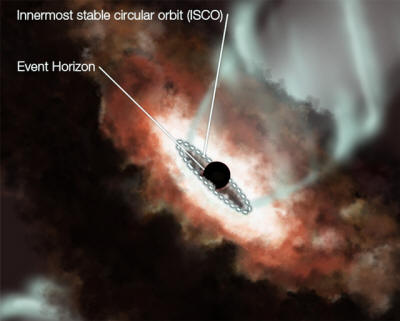|
September 28, 2012
the region immediately surrounding a supermassive black hole. The black hole is orbited by a thick disk of hot gas. The center of the disk glows white-hot, while the edge of the disk is shown in dark silhouette. Magnetic fields channel some material into a jet-like outflow - the greenish wisps that extend to upper right and lower left. A dotted line marks the innermost stable circular orbit, which is the closest distance that material can orbit before becoming unstable and plunging into the black hole (Chris Fach / Perimeter Institute & University of Waterloo)
The team examined the supermassive black hole at the center of a giant elliptical galaxy called Messier 87, which is located about 50 million light-years from Earth.
That black hole is 6 billion times more massive than the Sun. It’s surrounded by an accretion disk of gas swirling toward the black hole’s maw.
Although the black hole is invisible, the accretion disk is hot enough to glow.
According to Einstein’s theory of general relativity, a black hole’s mass and spin determine how close material can orbit before becoming unstable and falling in toward the event horizon.
The team was able to measure this
innermost stable orbit and found that it’s only 5.5 times the size
of the black hole’s event horizon. This size suggests that the
accretion disk is spinning in the same direction as the black hole.
The telescope is capable of seeing
details 2,000 times finer than the Hubble Space Telescope.
|

